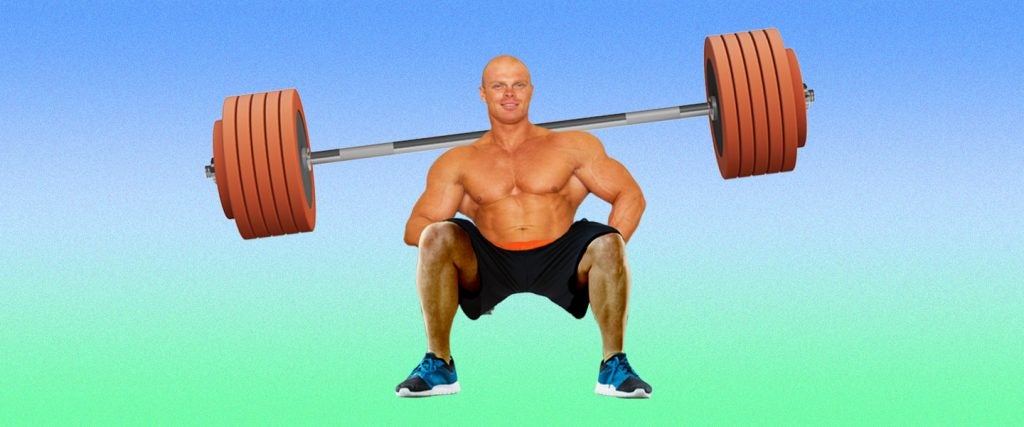The first two exercises that the members of our Bally Total Fitness training crew partook in during our Sunday afternoon leg day workout were leg presses and squats, in that order. One of the things that quickly stood out to me — as a leg-lifting novice — was how the leg press and the squat both utilized ostensibly the same motion, yet most of the personal trainers involved in our sessions could easily leg press three to four times the amount of weight they were capable of squatting.
“I don’t get it,” I told Chris, the hulking trainer who led the workout, after the first time I joined the group. “How is it that you’re doing squat sets of 10 with 405 pounds, and sets of 10 with over 1,300 pounds on the leg press?”
“Because the weight is on a fixed path when you’re doing the leg press,” he replied. “You’re basically pushing a sled up and away. You don’t have to control that whole weight with your body like you do on the squat.”
“I still don’t get it,” I said. “Why would it make that much of a difference?”
Chris simply smiled in response to my denseness. “I can’t wait until you get done with your training certification class,” he told me mockingly.
I don’t get it either. What makes leg presses and squats so different?
Absolutely nothing, but also absolutely everything.
For starters, leg presses are a closed-chain exercise, while squats are an open-chain exercise. With squats, your feet remain in a fixed position on the floor, you add additional weight to the natural resistance supplied by your body weight and you maneuver your body through the optimal path for supporting the weight while building muscle. You’re solely responsible for determining the path your body takes while it supports the weight, and as you struggle against the full force of gravity.
Leg presses necessitate that you move the weight away from your body along a predetermined path that’s typically set at a sloped angle of around 45 degrees. No matter how lousy your form may be — and regardless of how indirect and off-center the pressure you apply to the press plate might be — the weight sled is only capable of moving in two directions: either toward you or away from you. This means you’re at far less risk of injury in comparison to squats, and your body is capable of moving far more weight since your muscles aren’t also responsible for stabilizing your body and maintaining the path of the weight as it moves.
That’s fine, but do the two exercises work the same muscles?
Generally speaking, yes, the leg press and the squat have a tremendous amount of overlap between the muscles they work, especially in terms of how many lower-body muscles they involve. In fact, there’s a decent argument to be made that doing one of these compound movements eliminates the need for single-joint exercises to target the quadriceps or glutes.
So does this also mean that leg presses are just as good as squats all things considered?
That would be nice, wouldn’t it? It would certainly save people from having to support hundreds of pounds on their shoulders — combined with 60 to 70 percent of their body weight — while putting their knees and back at risk. Sitting still and sliding on and off of a padded seat also sounds infinitely more comfortable.
But the reality is, there’s a great deal of difference between squats and leg press in terms of the relevant, applicable power the exercises generate. A 2016 study randomly assigned trainees to two different training groups — a leg press training group and a squat training group — and had them train for eight weeks after having their squat jumps and countermovement jumps measured in tandem with their one-rep max squat lifts and their isometric maximum strength. At the end of the prescribed training period, the strength levels and jumping abilities of both groups were once again assessed.
Ultimately, there were no differences between the squat and leg pressing groups with respect to maximum strength. But there were drastic differences in jumping ability, with participants in the squat group recording improvements of at least 12 percentage points in both the squat jump and countermovement jump, while the respective improvements in these areas for the leg press group were deemed to be statistically insignificant.
In other words, while leg pressing may be as effective as a lower body mass builder as several other leg exercises combined — and can even produce identical strength results to those of a squat by some measurements — it’s unable to deliver some of the athletic benefits that come from squats.
It sounds like I should squat.
There’s nothing stopping you from doing both. You just have to consider how much you want some additional spring in your step. The leg press is safer, the squat is more likely to produce an athletic result and each will add mass to your lower body. So why not double up and jump in with both feet?

